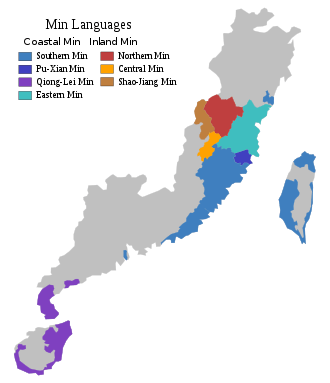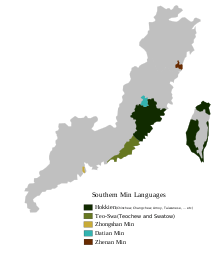Longyan Min
Longyan Min (龍巖閩語) or Longyan Minnan (龍巖閩南語), is a Southern Min language spoken in the urban city area of Longyan (eastern Longyan) in the province of Fujian while Hakka is spoken in rural villages of longyan (western part) by the peasantry. The Longyan Min people had settled in the region from southern part of Fujian Province as early as the Tang dynasty period (618–907). Although Longyan Min has some Hakka influence to a limited extent by the peasant Hakka Chinese language due to close distance of rural village Hakka peasants of the region, Longyan Min is a close dialect of the Minnan language and has more number of tones than Hakka (8 as compared to 6). Longyan Min has a high but limited intelligibility with Southern Min dialects such as Hokkien–Taiwanese. Today, Longyan Minnan is predominantly spoken in Longyan's urban district Xinluo District while Zhangzhou Minnan is spoken in Zhangping City. Hakka on the other hand is spoken in the nom-urban rest of the rural areas of Longyan prefecture: Changting County, Yongding County, Shanghang County, Liancheng County and Wuping County.[2]
| Longyan Min | |
|---|---|
| 龍巖閩語 | |
| Native to | China. |
| Region | Fujian Province |
Native speakers | 740,000 (approx.) |
Sino-Tibetan
| |
| Language codes | |
| ISO 639-3 | None (mis) |
| Glottolog | zhan1240 Zhangping-Longyan[1] |
| Linguasphere | 79-AAA-jei /-jej |
 Distribution of Min Nan dialects. Longyan Min is in yellow. | |
Branner suggests that the Xinluo and Zhangping dialects should be grouped with the Datian dialect as a coastal Min group separate from both Southern Min and Eastern Min.[3] However, he argues that the dialect of Wan'an township, in the northern part of Xinluo district, is a coastal Min variety separate from all of these.[4]
Phonology
Longyan Min has 14 initials, 65 rimes and 8 tones.
Rimes
ue, ɛ, iɛ, uɛ, ai, uai, au, iau
m, im, am, iam, iep, ap, iap
in, un, an, ian, uan
it, at, iat, uat, uot, ŋ
aŋ, iaŋ, uaŋ, oŋ, ioŋ, ak, iak, uak, ok, iok
ĩ, ũ, ũi, ã, iã, uã, iuã, iãt, õ, iõ, ɛ̃, iɛ̃, uɛ̃, ãi, ãu, iãu.
Tones
| No. | 1 | 2 | 3 | 4 | 5 | 6 | 7 | 8 |
|---|---|---|---|---|---|---|---|---|
| Tones | dark level 陰平 |
light level 陽平 |
dark rising 陰上 |
light rising 陽上 |
dark departing 陰去 |
light departing 陽去 |
dark entering 陰入 |
light entering 陽入 |
| Tone contour | ˧˧˦ (334) | ˩ (11) | ˨˩ (21) | ˥˨ (52) | ˨˩˧ (213) | ˥ (55) | ˥ (5) | ˧˨ (32) |
| Example Hanzi | 邊 | 寒 | 碗 | 近 | 漢 | 尺 | 曲 | 白 |
Tone sandhi
Longyan Min has extremely extensive tone sandhi rules: in an utterance, only the last syllable pronounced is not affected by the rules.
The two-syllable tonal sandhi rules are shown in the table below (the rows give the first syllable's original citation tone, while the columns give the citation tone of the second syllable):
| dark level, 334 | light level, 11 | dark rising, 21 | light rising, 52 | dark departing, 213 | light departing, 55 | dark entering, 5 | light entering, 32 | |
| dark level, 334 | ||||||||
| light level, 11 | ||||||||
| dark rising, 21 | ||||||||
| light rising, 52 | ||||||||
| dark departing, 213 | ||||||||
| light departing, 55 | ||||||||
| dark entering, 5 | ||||||||
| light entering, 32 | ||||||||
References
- Hammarström, Harald; Forkel, Robert; Haspelmath, Martin, eds. (2017). "Zhangping-Longyan". Glottolog 3.0. Jena, Germany: Max Planck Institute for the Science of Human History.
- Wurm, Stephen Adolphe; Li, Rong; Baumann, Theo; Lee, Mei W. (1987). Language Atlas of China. Longman. ISBN 978-962-359-085-3.
- Branner, David Prager (1999). "The Classification of Longyan" (PDF). In Simmons, Richard VanNess (ed.). Issues in Chinese Dialect Description and Classification. Journal of Chinese Linguistics monograph series. 15. pp. 36–83. p. 78.
- Branner, David Prager (2000). Problems in Comparative Chinese Dialectology — the Classification of Miin and Hakka (PDF). Trends in Linguistics series. 123. Berlin: Mouton de Gruyter. ISBN 978-3-11-015831-1.
- Compilation Commission of Chorography of Longyan City 龙岩市地方志编纂委员会 (1993). Long yan shi zhi 龙岩市志 ["Chorography of Longyan City"]. 36. Beijing: Zhongguo kexue jishu chubanshe 中国科学技术出版社 ["China Science and Technology Press"]. ISBN 978-7-5046-1575-6.

